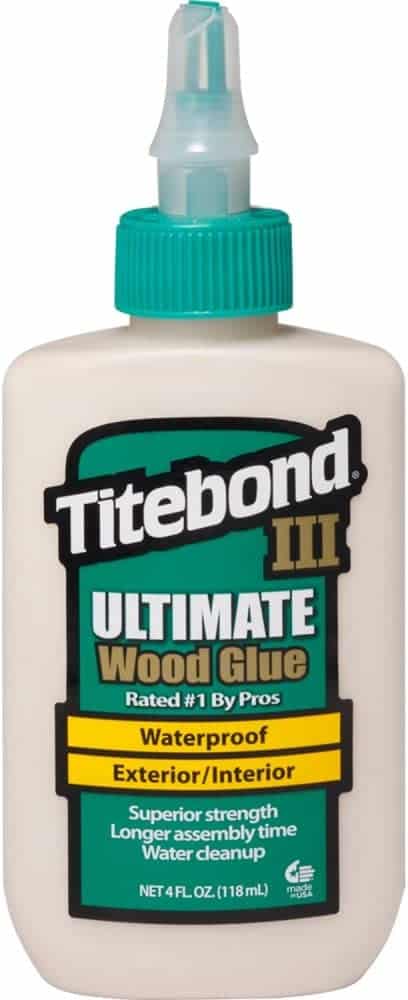The best adhesive for butcher block is the Titebond III. Titebond III is food safe, non-toxic, and water resistant. It will be permanently fixed to the butcher block.
For a more detailed answer, keep reading…
Table of Contents
What should I look for in an adhesive?
There are important characteristics to look for in a wood adhesive. Bond strength and cure time are at the top of the list. Other things to look for are the type of adhesive, how it is applied, viscosity, and whether it is indoor or outdoor.
Another thing to look for and take into consideration is…
- Types of materials the glue works on
- Working temperature
- Working time
- Set time
Strength
Wood glue strength can be measured, and it measures close to 3500 psi. on average, but can be as high as 4000psi. The glue strength generally exceeds the strength of the wood.
The strength of glue is determined by using three different types of tests.
- Tensile strength test
- Shear strength test
- Peel strength test
Tensile strength is measured at the point where the glue breaks.
Shear strength is a measurement of the strength when pulled in opposite directions..
Peel strength uses a peeling motion that measures the resistance to stress.
Different industrial uses require different amounts of strength.
Which Oils Can be Used on Butcher Block?
Cure time
Cure time is basically how long it takes for the glue to set. There are time differences in different types of glue. The amount of time that is needed to get the materials set in place, clamped, and adjusted is considered work time.
As time passes the bond becomes stronger and the ability to work with and move the material is dictated by the cure time. Cure time is generally around 24 hours.
Stressed joints require the entire 24 hours with the clamps in place to ensure the glue has cured completely before the joints are stressed.
Best adhesive for butcher block countertop
The best adhesive for a butcher block countertop is a glue that is safe for indirect food contact, waterproof and non-toxic.
The best adhesives for a butcher block countertop would offer strength, durable bonding, versatile application, a strong initial tack, and is sandable.
Open time and working time can be a deciding factor in what makes the best adhesive for butcher block countertops. Open time is the time between the application of the glue and the two pieces of material being joined together. Working time is the time from start to finish.
One adhesive in particular stands out. Titebond III is used by many expert woodworkers and is considered to be the best glue for countertops.
Want us to remove and install your new kitchen? View our kitchen fitters near you in Brum.
Epoxy
Epoxy is a polymer resin made up of two separate components. The epoxy resin and a hardener. When the hardener is added to the epoxy resin it begins to “cure” which means it’s beginning to harden and set up. The total time of cure depends on the amount of hardener used.
Using a thin epoxy resin the adherence to wood is exceptional and can last up to 20 years if properly maintained.
Epoxy is indirect food safe and non-toxic as well as waterproof.
Titebond 3

Titebond 3 is a woodworking glue with several exceptional benefits. Titebond 3 waterproof glue is the first one-part glue that can be cleaned up with water while wet.
Other Benefits of Titebond 3:
- Solvent-free
- Non-toxic
- Strong initial tack
- 20-25 minute total assembly time
How To Remove Dried Titebond III Glue
To remove dried Titebond III glue a solvent can be used as long as the wood has not been treated. Using a solvent like acetone is recommended for unfinished wood only. For a gentler alternative vinegar can be used as well.
Another method is to scrape and sand the dried glue. It’s possible to use a paint scraper and hand sand or use a belt sander to remove the dried glue from the wood surface.
How to Remove Stains from Butcher Block
How To Join Butcher Block Countertops In A Corner
There are several ways that a butcher block can come into a corner. To join the butcher block countertops in a corner depends on the type of installation. Is it mitered, squared off, or butted up against each other? If the corner is a 45° miter, miter bolts and joint fasteners can be used.
Biscuits, pocket holes, or miter clamps are all options when joining the butcher block at the corner. Special tools may be needed like a plunge router, biscuit joiner, and bits for drilling the pocket holes. Also for these applications jigs will be necessary.
Attaching the countertop to the wall in the corner requires wooden cleats made of ¾ plywood cut into rectangular blocks that are drilled vertically and horizontally allowing for the drawing in and snugging up the countertop into the corner.. Through the cleats and into the countertop with a little assistance from a helper the countertop can be placed firmly into a corner.